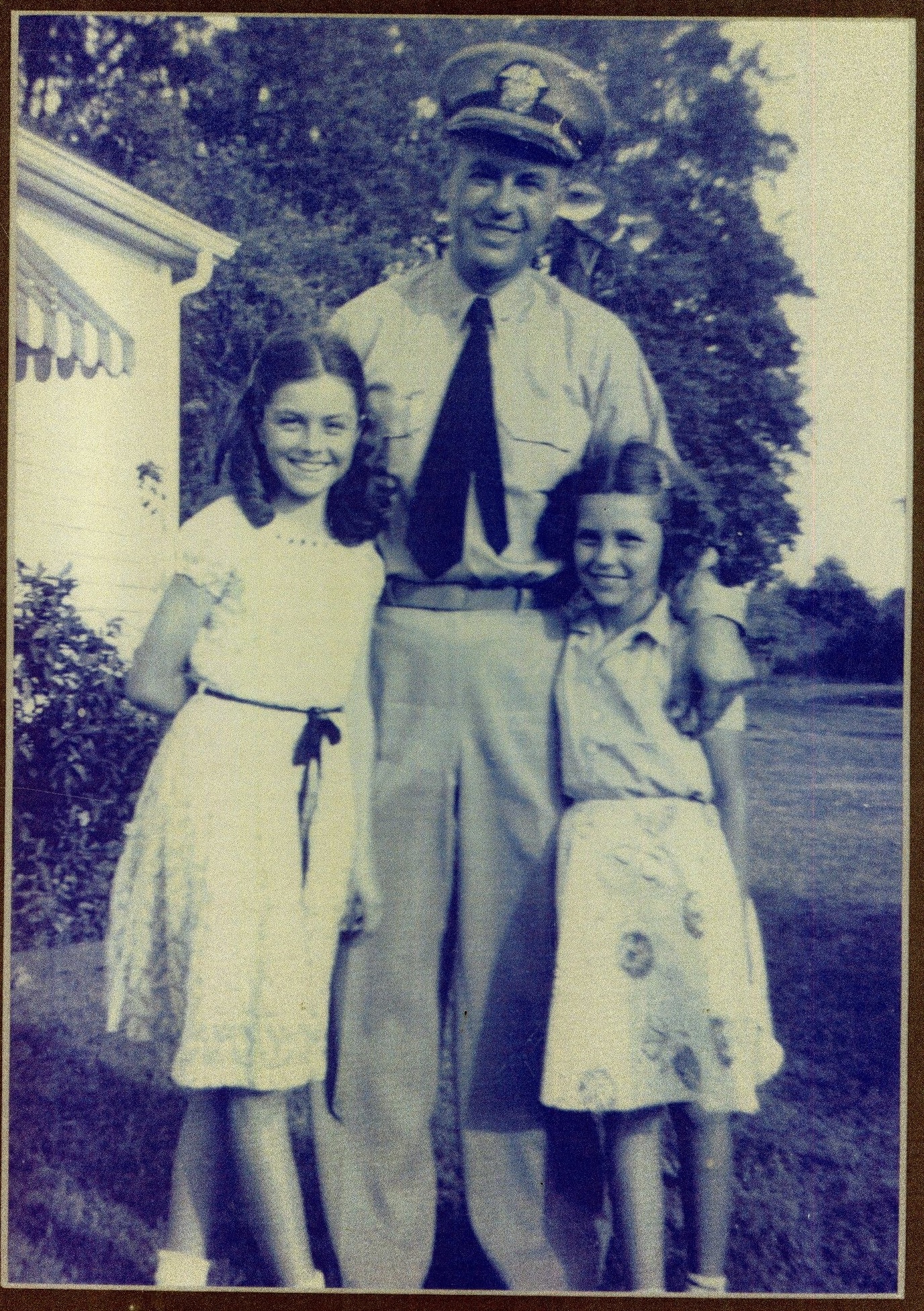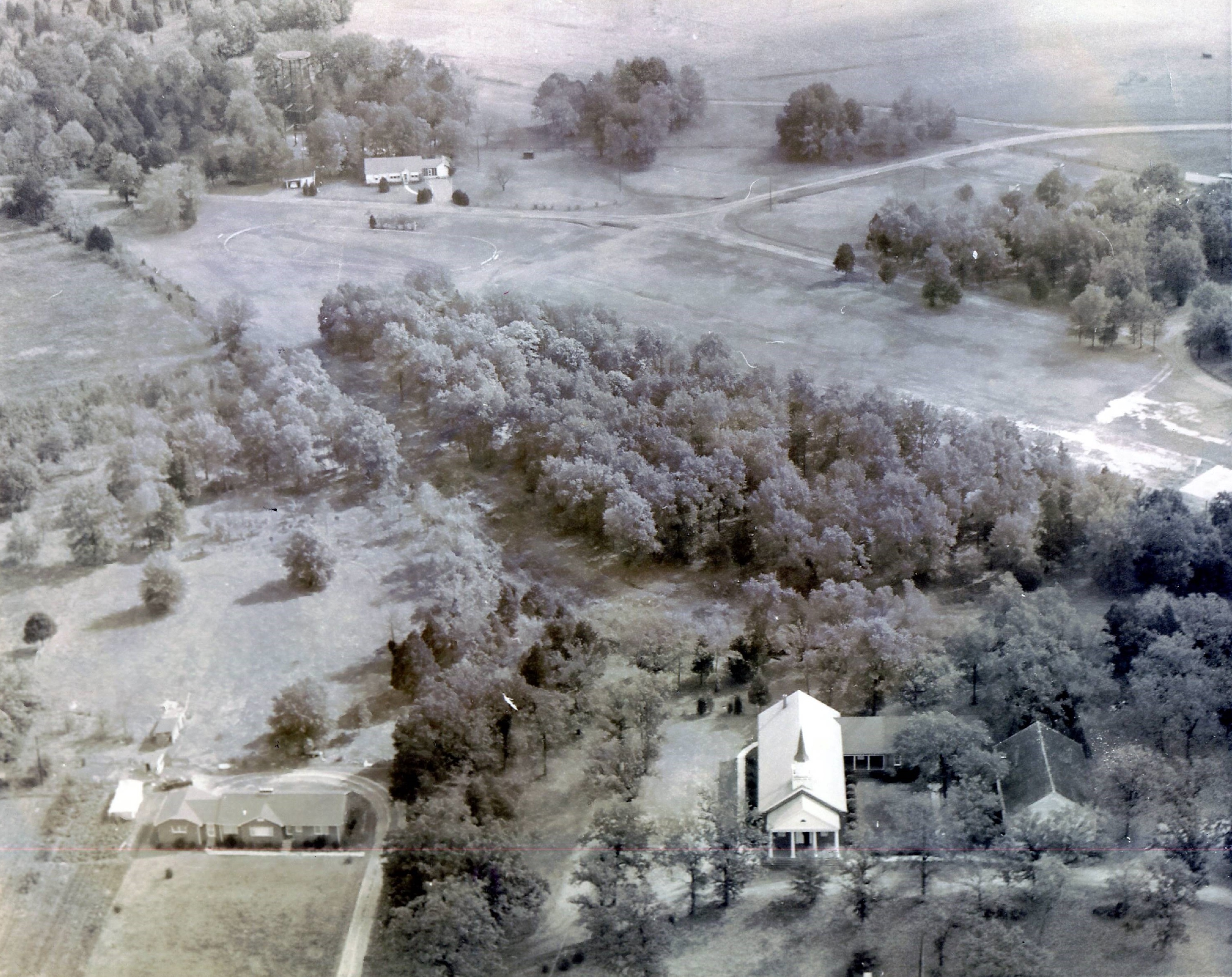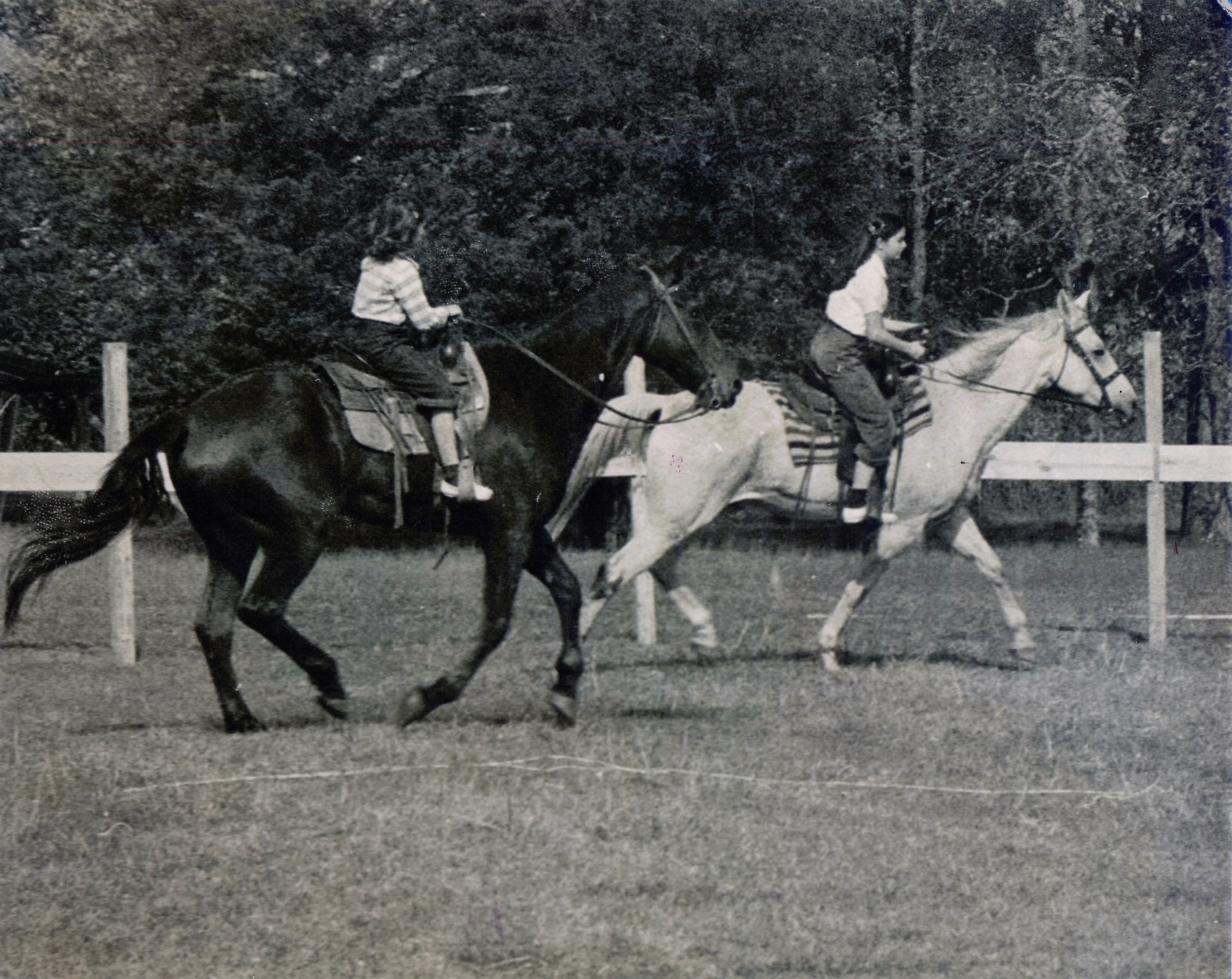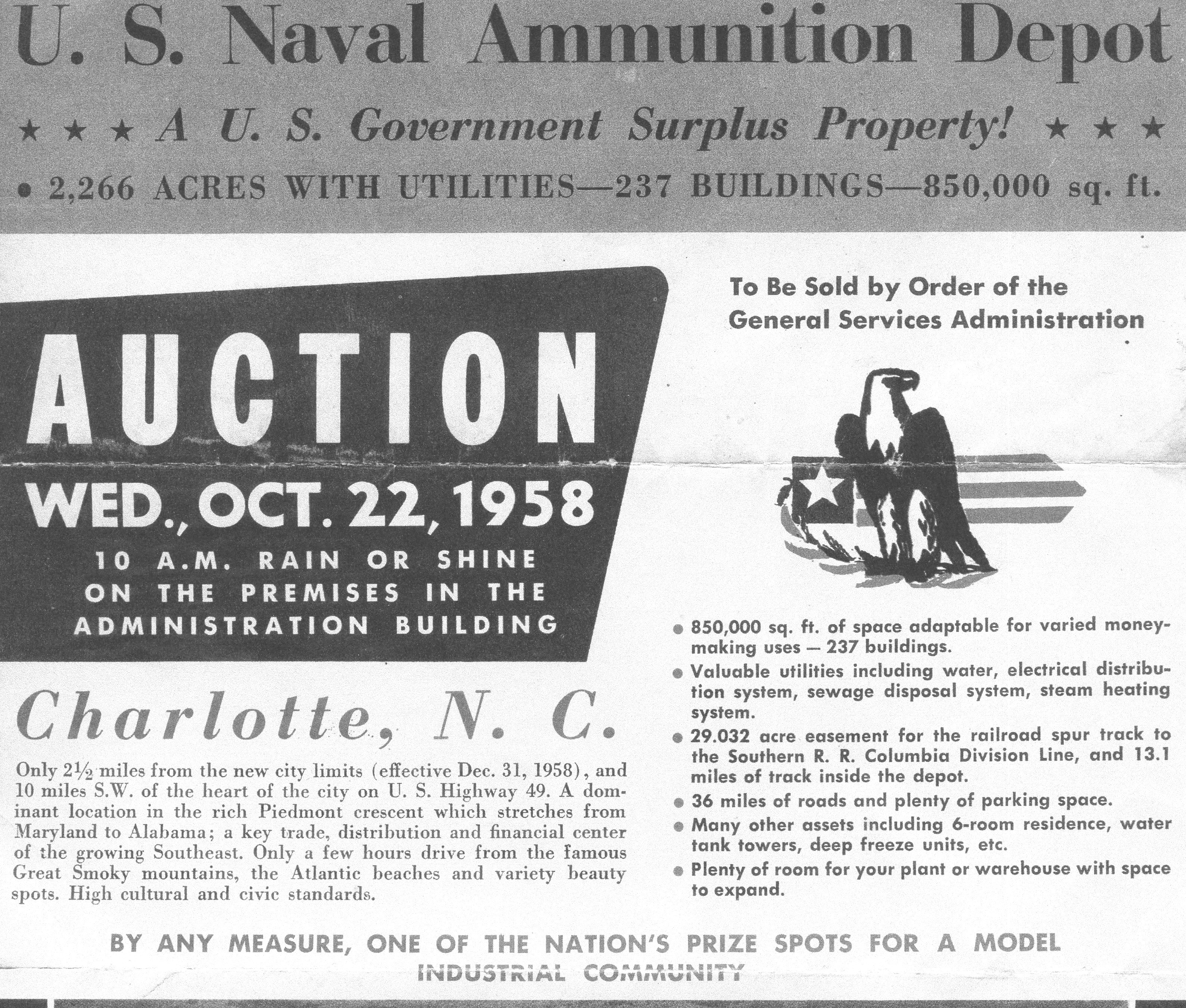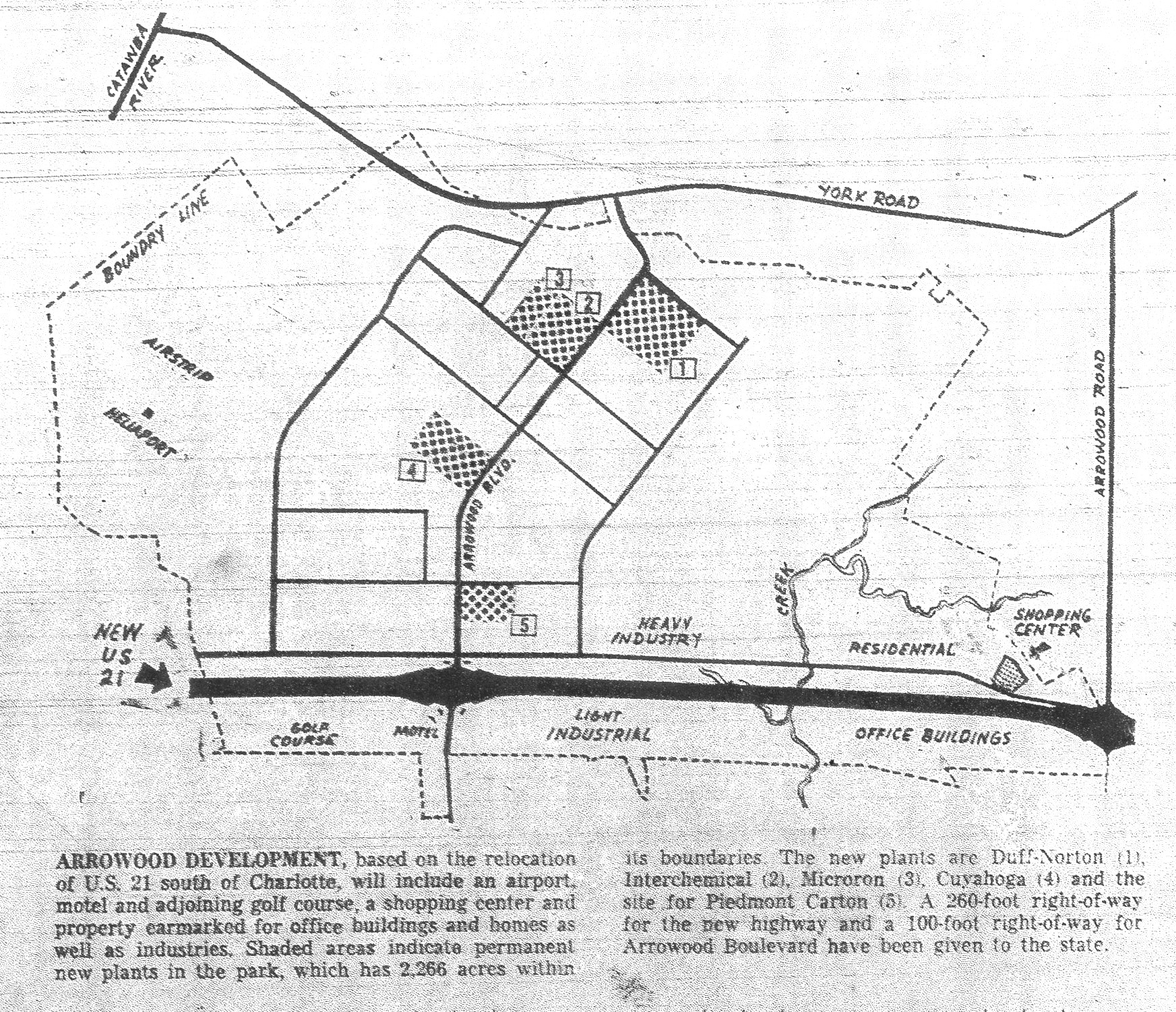|
The Shell Plant Becomes Arrowood Business Park (Part 3 of 3) (October 17, 2018) This is the third of three articles adapted from stories collected or written by Walter Neely and published in Gleanings, Newsletter of the Steele Creek Historical and Genealogical Society. See also:
Summary:
Why Do We Have So Much Industry? It All Started with the Shell Plant History of the Shell Plant – Part 3 Part 3 will conclude the history of the Shell Plant and its successor, the Arrowood Business Park. It looks at what happened to the plant following the end of World War II, its sale, and its eventual development into the important economic engine that it is today.
In
Part 2, the war had ended and the Shell Plant had effectively closed
down. Two days after the end of the war, the
contract with U. S. Rubber Company was cancelled. However, the U. S.
Rubber Company sold the property to the United States of America on
May 18, 1945, for $267,765.27. (Mecklenburg County Register of
Deeds, Book 1115 Page 148.) The property total in this deed was
2,266.319 acres and right of way for a railroad spur tracks was over
29.032 acres. This was only slightly more than the $246,567.50 that
U. S. Rubber Company paid for the land they acquired in 1942. Peggy White Levinson's father, Herbert L. White, was the last Commander of the Navy base, and her family was the last to leave in June, 1957. They lived in Quarters A, near the water tower. She and her sister, Vivian, attended Steele Creek Elementary School when she was in the 2nd, 3rd, and 4th grades. She and her sister remember the base, the land, the freedom, roller skating in the buildings, walking on the railroad tracks, riding horses up the bunkers (after they were cleaned out), and lots of other adventures. They had a barn and riding ring for their horses. During the 1950’s, the military conducted War Games on the property, and she would ride her horse to watch the activities. Her father developed a good relationship with nearby farmers and permitted them to let their cows graze on the property. There were other families living on the base and perhaps a dozen children waited for the school bus at the guard house with the Marines. She developed a close relationship with the Marines, who even “baby sat” with her and her sister. However, the Marines were not past reporting the children to their parents when they were caught climbing up the water tower or chasing cows in a neighbor’s pasture. She reported that this was an enjoyable time in her childhood of which she has very fond memories.
The White home was known as “Quarter’s A” and is at the top of the picture. Central Steele Creek Presbyterian Church is at the bottom. Click on the image above to see an enlargement in a new tab. The riding ring is in front of the house, and the framework for the water tower is in the trees behind the house.
Peggy and Vivian White riding their horses in the ring at the Shell Plant.
The following information is extracted from the article,
Reflecting On Charlotte’s Growth: History of the Westinghouse Area
by Barbara Russell. It contains several quotes from former Steele
Creek Historical and Genealogical Society
member, Max Funderburk. Additional information was found in a folder
from the Steele Creek Historical and Genealogical Society file cabinet at the Steele Creek Branch Library. It
included ownership and development information that was intended for
distribution to interested businesses and investment brokers.
In 1958, a group headed by Mr. Paul Younts (then
president of the Charlotte Chamber of Commerce) and local officials
approached congressman Charles R. Jonas to see if the government
would release the property for sale and development. Finally, the U.
S. Navy released it and turned it over to the General Services
Administration who authorized it to be sold. The advertisement for
the auction is shown below. Click on the image to
see an enlargement in a new tab.
The following are excerpts from an article in The Charlotte
Observer, December 10, 1961, page 16C, by Harry Snook. Written just
over a year after the acquisition of the property from the GSA, some
of the plans, though optimistic, never came to pass. This to Pat Hall is barely the start. “Eventually we’ll have 18,000 people working out here, and a payroll of $75 million a year or more” he said explaining that the projection was based on established principles of land use. The projection is over the next 14 years. Visitors to Arrowood recently have literally gaped at the transformation of what was “ghost land.” There’s the brand new brick-and-steel Duff-Norton plant on a 26 acre trace. More than 200 workers collect regular paychecks there. More than 500 persons are employed by Cuyahoga Products in a modern plant built a few months ago on a 15 acre tract. Three divisions of Interchemical Corp. with more than 60 employees have just recently moved into the building on another 15 acre tract. Microton has 75 or more people at work in its new plant on seven acres of landscaped property. The other industries, furniture manufacturers, trucking firms, an aircraft rebuilder, and others are in the old ammunition depot buildings. Many of the old buildings have already been torn down. Eventually the old buildings will all be gone replaced by carefully restricted modern buildings. He iterated that “We haven’t been pushing hard. We’ve wanted to keep the land clear until the highway was settled, so we could plan the whole thing and not wind up by botching somewhere.” Already, and looking far ahead, Hall has a 100,000 gallon –a-day sewage disposal plant in operation with only a fifth of this capacity being utilized. Yet the plant is designed so that its capacity can be quickly and economically doubled. “We’ve got the electricity. We’ve got natural gas. And there are already 15 miles of railroad tracks here that connect to Southern’s main line.” Generous right of way has been allocated for the 36 miles of roads now at Arrowood, and future roads will be treated the same. “If you don’t plan for the traffic 20 years from now, you’ll wind up in a snarl,” he grinned. The biggest road of all, of course, is to be U. S. 21 which will change the main entrance of Arrowood from the York Road on the northwest to the southeast edge of the property. To avoid criticism, Hall and his associates gave nearly 95 acres of land worth an estimated $300,000, to the state for the highway right-of-way. “We could have sold the land in good conscience,” Hall said. “This route chose by the highway people is the logical one. It’s a straight shot, and will handle the heavy traffic we’ll be generating.” Hall noted that the original plans years ago for relocation of U. S. 21 called for passage through what now is Arrowood. “The federal government as owners of the property, said no.” Hall said. “Fortunately, we were able to say yes.” This superhighway will run through Arrowood for more than two and a half miles, leaving a strip 800 feet deep on the southeast side of the highway and across from the big bulk of the property. Two interchanges or cross-over turnoffs will be in Arrowood. The biggest one at Arrowood Boulevard, provides a choice site for the 80 room motel and 18 hole golf course planned by Hall – in the extreme southeast corner and taking up about 125 acres. “There’ll be more than 30,000 cars a day moving along that highway,” said Hall. “Tell me; is there a deluxe motel south of the city now? Or a motel with an adjoining golf course in this area?” “Our idea is the combine the golf course with a private club and permit the motel guests to use the course,” he said. At the other interchange, a couple of miles to the northeast, where Arrowood Road will cross the highway, a shopping center is planned in the northwest corner. “We’ll start with a service type center,” he said. “We already need it – a restaurant, barber shop, service station, and the like – with the people we have working out here.” The basic service firms should be in operation within the next two years, according to Hall’s timetable. To be added later: retail stores, a medical clinic, and recreation facilities such as a bowling alley. Between the shopping center and the creek to the southwest, about 350 acres of land have been earmarked for residential development – up to 500 homes. “People who’re working out here have been asking when we’d make land available for homes,” Hall said. “It’s just like the medial clinic – we’re talking with several doctors who’ve been interested for months now. Detailed plans have been made for a paved, 3,000 foot airstrip in the eastern part of Arrowood. Hall said the project stemmed from a need expressed by corporate executives, but probably would involve a complete, privately operated airport. Between the service roads paralleling the new highway and the highway itself, Hall has marked land for light industries. The big plants will go beyond the service roads on the other side of them from the highway and elsewhere on the sprawling Arrowood. Although shying away from any guess on the total amount of money his plans involve, Hall admitted the “whole works will involve millions – and we’re talking about more than just a couple of years.” Lest anyone lean toward adding a pinch of salt to Hall’s plans, which he says are “flexible.” It shouldn’t be overlooked that Arrowood already represents an investment of millions. “We didn’t buy this land to farm,” Hall said.
Arrowood
he pointed out is “ten minutes from the Square, eight minutes from
Douglas Airport, six minutes from the Catawba Lake recreation area,
and right in the middle of what may well be the greatest
concentration of population in the whole South a few years from
now.” As Hall sees it, Arrowood’s ultimate development is only a
matter of time – and a lot of planning ahead.
The plan above was
included with the article. Click on the image to see an enlargement
in a new tab. In conclusion, the Shell Plant, and later Arrowood, did become a major impact to the Steele Creek Community providing employment for thousands and stimulated development along South Tryon St. and Westinghouse Blvd. to the west. It was an important impetus that changed our sleepy, agricultural neighborhood into the growing and bustling community in which we live today. See also:
Summary:
Why Do We Have So Much Industry? It All Started with the Shell Plant To comment on this story, please visit the Steele Creek Forum.
Click here:
|



